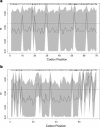Evolutionary genetics of MHC class II beta genes in the brown hare, Lepus europaeus
- PMID: 21688061
- PMCID: PMC3190090
- DOI: 10.1007/s00251-011-0539-3
Evolutionary genetics of MHC class II beta genes in the brown hare, Lepus europaeus
Abstract
The genes of the major histocompatibility complex (MHC) are attractive candidates for investigating the link between adaptive variation and individual fitness. High levels of diversity at the MHC are thought to be the result of parasite-mediated selection and there is growing evidence to support this theory. Most studies, however, target just a single gene within the MHC and infer any evidence of selection to be representative of the entire gene region. Here we present data from three MHC class II beta genes (DPB, DQB, and DRB) for brown hares in two geographic regions and compare them against previous results from a class II alpha-chain gene (DQA). We report moderate levels of diversity and high levels of population differentiation in the DQB and DRB genes (Na = 11, D (est) = 0.071 and Na = 15, D (est) = 0.409, respectively), but not for the DPB gene (Na = 4, D (est) = 0.00). We also detected evidence of positive selection within the peptide binding region of the DQB and DRB genes (95% CI, ω > 1.0) but found no signature of selection for DPB. Mutation and recombination were both found to be important processes shaping the evolution of the class II genes. Our findings suggest that while diversifying selection is a significant contributor to the generally high levels of MHC diversity, it does not act in a uniform manner across the entire MHC class II region. The beta-chain genes that we have characterized provide a valuable set of MHC class II markers for future studies of the evolution of adaptive variation in Leporids.
Figures


Similar articles
-
Positive selection and climatic effects on MHC class II gene diversity in hares (Lepus capensis) from a steep ecological gradient.Sci Rep. 2018 Jul 31;8(1):11514. doi: 10.1038/s41598-018-29657-3. Sci Rep. 2018. PMID: 30065344 Free PMC article.
-
Patterns of evolution in MHC class II DQA and DQB exon 2 genes of Alpine mountain hares, Lepus timidus varronis, and sympatric and parapatric brown hares, L. europaeus, from Switzerland.Immunogenetics. 2024 Feb;76(1):37-50. doi: 10.1007/s00251-023-01328-2. Epub 2023 Dec 20. Immunogenetics. 2024. PMID: 38114658
-
Evolutionary history of an MHC gene in two leporid species: characterisation of Mhc-DQA in the European brown hare and comparison with the European rabbit.Immunogenetics. 2009 Feb;61(2):131-44. doi: 10.1007/s00251-008-0349-4. Epub 2008 Dec 23. Immunogenetics. 2009. PMID: 19104797
-
Genetic variation in the major histocompatibility complex of the European brown hare (Lepus europaeus) across distinct phylogeographic areas.Immunogenetics. 2014 Jun;66(6):379-92. doi: 10.1007/s00251-014-0772-7. Epub 2014 Apr 18. Immunogenetics. 2014. PMID: 24743946
-
Generation of MHC class II diversity by intra- and intergenic recombination.Immunol Rev. 1995 Feb;143:5-12. doi: 10.1111/j.1600-065x.1995.tb00667.x. Immunol Rev. 1995. PMID: 7558082 Review.
Cited by
-
Positive selection on MHC class II DRB and DQB genes in the bank vole (Myodes glareolus).J Mol Evol. 2014 May;78(5):293-305. doi: 10.1007/s00239-014-9618-z. Epub 2014 Apr 20. J Mol Evol. 2014. PMID: 24748547
-
Positive selection and climatic effects on MHC class II gene diversity in hares (Lepus capensis) from a steep ecological gradient.Sci Rep. 2018 Jul 31;8(1):11514. doi: 10.1038/s41598-018-29657-3. Sci Rep. 2018. PMID: 30065344 Free PMC article.
-
Immunogenetics, sylvatic plague and its vectors: insights from the pathogen reservoir Mastomys natalensis in Tanzania.Immunogenetics. 2023 Dec;75(6):517-530. doi: 10.1007/s00251-023-01323-7. Epub 2023 Oct 19. Immunogenetics. 2023. PMID: 37853246 Free PMC article.
-
Patterns of evolution in MHC class II DQA and DQB exon 2 genes of Alpine mountain hares, Lepus timidus varronis, and sympatric and parapatric brown hares, L. europaeus, from Switzerland.Immunogenetics. 2024 Feb;76(1):37-50. doi: 10.1007/s00251-023-01328-2. Epub 2023 Dec 20. Immunogenetics. 2024. PMID: 38114658
-
Hybridization with mountain hares increases the functional allelic repertoire in brown hares.Sci Rep. 2021 Aug 4;11(1):15771. doi: 10.1038/s41598-021-95357-0. Sci Rep. 2021. PMID: 34349207 Free PMC article.
References
Publication types
MeSH terms
LinkOut - more resources
Full Text Sources
Research Materials
Miscellaneous

